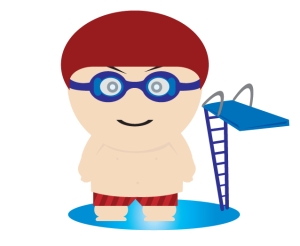 Swimming is a wonderful sport that thrives on your ability to have fun and be imaginative while in the water. At the same time, swimming is also an activity that revolves around exploring and understanding some basic principles in physics, namely the effects of water resistance and buoyancy. In fact, you can’t really call yourself an accomplished swimmer unless you comprehend and are able to put these two basic principles into practice.
Swimming is a wonderful sport that thrives on your ability to have fun and be imaginative while in the water. At the same time, swimming is also an activity that revolves around exploring and understanding some basic principles in physics, namely the effects of water resistance and buoyancy. In fact, you can’t really call yourself an accomplished swimmer unless you comprehend and are able to put these two basic principles into practice.
Improving by going back to the basics
It’s possible that some of you reached a point when you want to develop a method of swimming that promotes the best use of your body. To achieve this goal and improve your technique, you will have to possess a wide repertoire of skills. Without denying that you can meet this objective by re-learning the four basic strokes, take note that the same can be achieved equally effectively without having to swim from one end of the pool to the other. In the following article, we will discuss about two of the fundamental principles in swimming, balance and working with water resistance.
Resistance – How to stop struggling against the water
Regardless of your skills as a swimmer, one thing is for sure: you have probably noticed the differences in terms of movement in water and on land. These differences are dictated by resistance or more accurately, hydrostatic pressure, which is ten times higher in water than in the air. Take note that the pressure tends to increase as you sink deeper into the water. A simple test to prove this fact implies swishing your hand back and forth just beneath the water surface and then performing the same action deeper in the water. As you can see, executing the latter action will require a lot more effort.
In addition to slowing the swimmer down, the pressure is also beneficial for the nervous system. In fact, hydrotherapy is the part of medicine that acknowledges the therapeutic effects of moving in water, particularly for neurological conditions. If you want proof, then look no further than Christopher Reeve, the most emblematic actor to play the role of Superman. After his serious riding accident, Reeve became a quadriplegic; nevertheless, all his beliefs regarding his conditions changed when he discovered he could partially move his legs underwater.
Balance – How to achieve a horizontal body position
The trademark of every efficient swimmer is the ability to achieve a horizontal body position; while most of us can float on water, few of us can do it while standing horizontally. Because the innate tendency of the lower body is to sink, whereas that of the upper body is to float, achieving balance and stability in water is easier said and done. On a side note, this tendency is due to the fact that our center of buoyancy is located in the torso (the air in the lungs) and because our center of mass is usually around the hip area.
As any experienced swimmer will point out, achieving the horizontal position could be easier if you allow the water to support your body. Then again, if you try to resist it even a little bit, then you will immediately notice how your legs tend to drag you down. The ability to maintain your balance in a dynamic situation – while moving your arms and legs to create propulsion and move in water – is naturally more difficult to obtain than in static conditions. The key to ‘letting go’ and maintaining a horizontal position implies fine-tuning the alignment of the head with the direction of the limbs.
In the event you want to test this theory and see just how much the head-arms alignment influences your ability to keep a horizontal position, then submerge in water face down; can you notice how every slight movement of your head influences the position of the rest of the body? Because your head guides the motion of your body in water, it’s self-explanatory why you need to learn to maintain a good head-neck-back relationship.
The bottom line is that efficient swimming implies the ability to balance to maintain stability. Being aware of this minor, yet crucial aspect of swimming will not only improve your posture when swimming, but its effects can be applied to other sports you enjoy doing as well.
Take a look at Only Swimmers for more swimming lessons.










